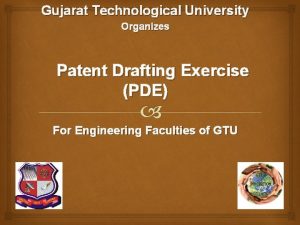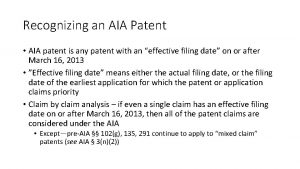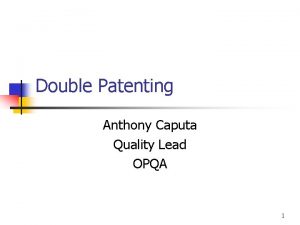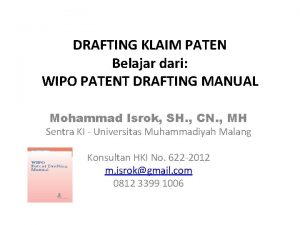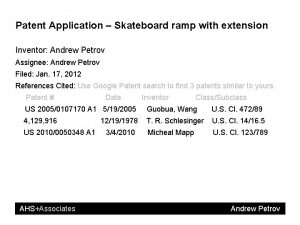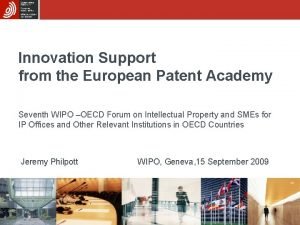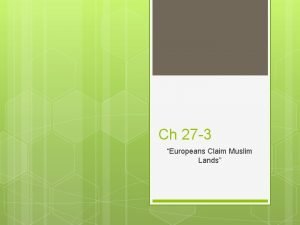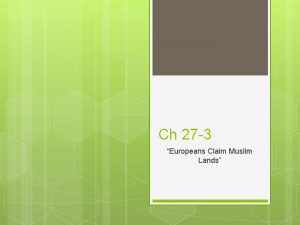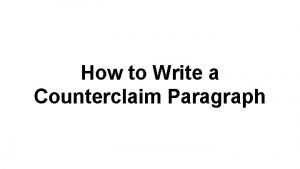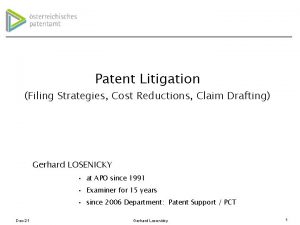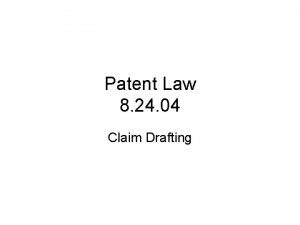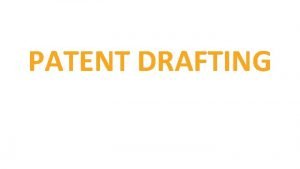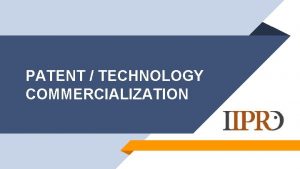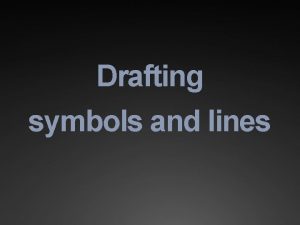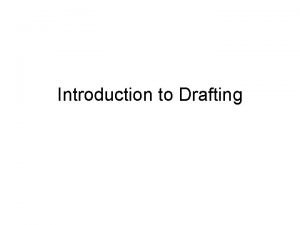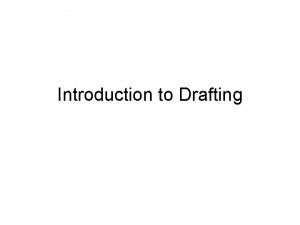Claim drafting strategies when filing a European patent












- Slides: 12

Claim drafting strategies when filing a European patent application or entering the European phase of a PCT-application Christof Keussen 22. 05. 2021 www. glawe. de 1

Legal Basics • Art. 84 EPC – Concise claims • The claims shall define the matter for which protection is sought. They shall be clear and concise and be supported by the description • Rule 43(2) EPC – One independent claim per category • Principle: one independent claim in the same category (product, process, apparatus or use) • Multiple independent claims only if the subject-matter of the application involves one of the following: 22. 05. 2021 • (a) a plurality of interrelated products, • (b) different uses of a product or apparatus, • (c) alternative solutions to a particular problem, where it is inappropriate to cover these alternatives by a single claim. www. glawe. de 2

Legal Basics • Rule 43(3) EPC – Multiple dependencies allowable • A dependent claim directly referring to another dependent claim shall also be admissible. • Rule 45 EPC – Claim fees • EUR 235 per claim from claim 16 to 50 • EUR 580 per claim from claim 51 onwards • Claim fees prohibitive, therefore a maximum of 15 claims advisable • Multiple dependencies may help to reduce number of claims without giving up scope 22. 05. 2021 www. glawe. de 3

Legal Basics • Rule 62 a(1) EPC – No search for multiple independent claims • If the European Patent Office considers that the claims as filed do not comply with Rule 43(2), it shall invite the applicant to indicate, within a period of two months, the claims complying with Rule 43(2), on the basis of which the search is to be carried out. If the applicant fails to provide such an indication in due time, the search shall be carried out on the basis of the first claim in each category. • No possibility to pay additional search fees to obtain a full search 22. 05. 2021 www. glawe. de 4

Legal Basics • Rule 64 EPC – Search in case of lack of unity • Partial search report for first mentioned invention • Opportunity to pay additional search fees to have other inventions searched • Divisional applications will have to be filed to prosecute other inventions • Rule 164 EPC – Supplementary Search for EP derived from PCT • New, as of 1 November 2014 the procedure will be essentially the same as for EP direct applications • Rule 137(2) EPC • Only one opportunity to amend the claims freely • Subsequent amendments require consent of examining division 22. 05. 2021 www. glawe. de 5

Legal Basics • Rule 45 EPC – Claim fees • EUR 235 per claim from claim 16 to 50 • EUR 580 per claim from claim 51 onwards • Rule 62 a(1) EPC – No search for multiple independent claims • 22. 05. 2021 If the European Patent Office considers that the claims as filed do not comply with Rule 43(2), it shall invite the applicant to indicate, within a period of two months, the claims complying with Rule 43(2), on the basis of which the search is to be carried out. If the applicant fails to provide such an indication in due time, the search shall be carried out on the basis of the first claim in each category. www. glawe. de 6

Claim drafting – The Approach • The wishlist: • Coverage for all aspects of the invention and the full stream of commerce (intermediate products etc. ) • Validity over the prior art • Difficult to design around • Step 1 • Define the most important aspect of the invention • Step 2 • Draft a main claim directed to this aspect • Step 3 • 22. 05. 2021 Build a claim set around this main claim to cover commercially relevant embodiments www. glawe. de 7

Practical Example • The invention: • A novel way of controlling a combustion engine embodied in an engine control unit • Step 1 • The core of the invention are the control process and control parameters • Step 2 • Appropriate main claim to cover this is: • A method of controlling a combustion engine comprising the steps of… 22. 05. 2021 www. glawe. de 8

Practical Example • Step 3 – dependent claims to cover the stream of commerce • a computer program product for performing the method • an engine control unit comprising the computer program product • an engine comprising the engine control unit • a vehicle comprising the engine • This claim set starts from a single independent claim but still covers the full range of commercial embodiments • The claim cascade begins with the key element (the control method) and moves on to the smallest commercial embodiment incorporating the key (computer program product) • The cascade continues with increasingly larger entities (ECU, engine, complete car) incorporating/using the key element 22. 05. 2021 www. glawe. de 9

Practical example – EP derived from PCT • PCT claim sets need to be suitable for many jurisdictions, including the US requiring a multitude of independent claims • The problem: Reducing the total number of claims to 15 while maintaining the broadest possible coverage • The approach: Make use of multiple dependencies • A typical (US-style) PCT claim set: • Claim 1 : Device A • Claims 2 -5: Preferred embodiments B, C, D and E • Claim 6: A method involving the use of device A • Claims 7 -10: Preferred embodiments of the method including B, C, D and E 22. 05. 2021 www. glawe. de 10

Practical example – EP derived from PCT • The reduced EP claim set: • Claim 1 : Device A • Claim 2: Preferred embodiment comprising at least one element selected from the group consisting of B, C, D and E • Claim 3: A method involving the use of a device according to claim 1 or 2 • Instruments used for the reduction: • Multiple dependencies of new claims 2 and 3 • Markush group in new claim 2 to cover embodiments B to E both in isolation and combination in a single dependent claim • Method claim 3 is multiple dependent on product claims to define preferred embodiments of the method 22. 05. 2021 www. glawe. de 11

Thank you Questions? keussen@glawe. de 22. 05. 2021 www. glawe. de 12
 Pde form 2 gtu
Pde form 2 gtu Patent effective filing date
Patent effective filing date Opqa
Opqa Patent effective filing date
Patent effective filing date Wipo patent drafting manual
Wipo patent drafting manual Patent attorney side business drafting drawings
Patent attorney side business drafting drawings Example of claim and counterclaim
Example of claim and counterclaim European patent academy courses
European patent academy courses Chapter 27 section 3 european claim muslim lands
Chapter 27 section 3 european claim muslim lands Chapter 27 section 3 european claim muslim lands
Chapter 27 section 3 european claim muslim lands Chapter 27 section 3 european claim muslim lands
Chapter 27 section 3 european claim muslim lands Chapter 11 section 3 european claim muslim lands
Chapter 11 section 3 european claim muslim lands Examples of counter claims
Examples of counter claims
